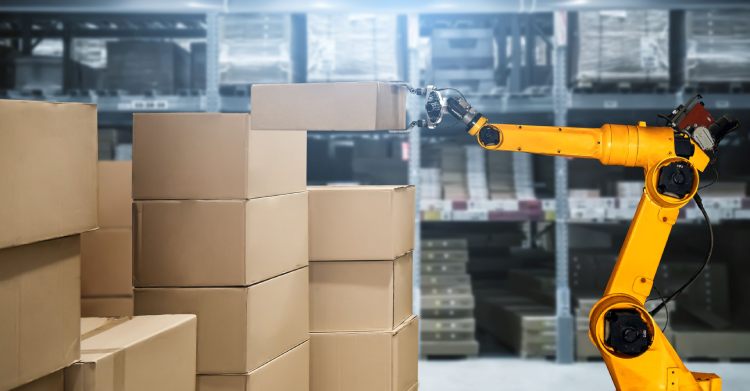The Impact of Robotics on Supply Chains

Robotics on Supply Chains
If the COVID-19 pandemic has taught the world, one thing is that supply chains are perhaps more vulnerable than previously thought. Supply chains the world over have never been immune to crisis and uncertainty. With the well-known volatility made all the more apparent by COVID-19, businesses are leveraging robotics to help provide stability in an otherwise uncertain world.
The Achilles heel of any business is the inability to plan for and react to supply chain disruptions that jeopardize operations. Robotic technology aims to mitigate some risks inherent in global supply chains. This article will examine how robotic technologies have and will continue to alleviate global supply chain woes.
Table of Contents
What is a Supply Chain, and Why is it so Vulnerable?
Simply put, a company’s supply chain consists of all the individuals, companies, resources, and technology. Involved in turning raw materials into viable products and their subsequent distribution and sale. For example, an automaker’s supply chain consists of hundreds of interconnected companies involved in the production and sale of a vehicle. Ranging from those that extract the raw materials from the earth used to produce navigational equipment and tires up to and including the dealership that sells the finished product. Supply chains, for the most part, are very well structured, organized, and efficient. Ideally, each company. That makes up the supply chain is carefully vetted to ensure that they can fulfill their responsibilities in the production flow.
So why, then, are supply chains so vulnerable?
The fact is, the more complicated the product, the more complicated the supply chain. Think of a supply chain as an ecosystem. The sudden removal of a seemingly innocuous organism, like an insect, can cause a ripple effect throughout the food chain, including the ecosystem’s dominant predator. If a company that is part of a supply chain fails or is otherwise unable to fulfill orders, the consequences can be unpredictable. When these unpredictable consequences are extrapolated on a macroeconomic scale, the results can be significant, ranging from a scarcity of goods to layoffs and even inflation.
In many respects, globalization has been an overwhelmingly positive force in economies worldwide. Competition between manufacturers is more significant; therefore, prices drop while quality improves. Disruptions to a global supply chain are rarely if ever, localized. This means that if production is disrupted due to a natural disaster in one country, that disruption can spread to one or more companies further down the supply chain thousands of miles away. Unfortunately, natural disasters are not the only threat to supply chains; additional disruptions can include:
- Conflict (i.e., war)
- Price volatility in sourcing/processing raw materials
- Human error
- Scarcity of labor
Additional factors, such as regional legislation, could disrupt a supply chain. As many countries continue to set goals to combat climate change, a once stable part of the supply chain may need to pivot its operations to comply with their respective laws.
Robotics Represent a Consistent Workforce

While robotics cannot put to rest all risks to any given supply chain, there is one facet of supply chain management. That this technology can certainly improve upon – scarcity of labor. The cost and design of high-quality robotics seem to enjoy an inverse relationship with one another (the cost of robotic systems continues to drop while the design and performance of said systems continue to improve). Given that, it is becoming much more accessible for manufacturers of all sizes to invest in robotics. And integrate them throughout their operations.
Companies that utilize robotics can reduce the size of their human workforce without jeopardizing output, which became necessary during the height of the pandemic. When non-essential personnel was furloughed or repositioned to work remotely. Pandemic aside, robotics is more consistently utilized to perform hazardous tasks, which poses a risk to human health. Workplace injuries are declining, as are any injury-related supply chain issues.
Increased Supply Chain Efficiency
Robotics can also play a significant role in improving margins within a supply chain. Autonomous robots work quickly, efficiently, and tirelessly, improving processes like order fulfillment and delivery of goods. This, in turn, can positively impact customer satisfaction. Which can solidify a company’s position within a well-established and lucrative supply chain. Lower costs of production not only make a company more profitable. The savings can also be passed down to the end consumer, who can then enjoy.
The additional benefit of having a greater degree of purchasing power. More purchasing power leads to more economic activity, allowing manufacturers to invest further in the technologies. That will improve their operations. Besides that, robotics provides a measure of production certainty in a world. That continues to show that it is anything but certain. In short, the increased use of autonomous robotics within a supply chain can have numerous benefits besides those one might expect.
Autonomous Robots: Vital Components to Today’s Supply Chains
A business that fails to identify and plan for disruptions to its supply chain is doomed to fail. Robotic technology will continue to play a vital role in mitigating some risks inherent in global supply chains.
As globalization expands and supply chains grow in complexity, there will be more risks. To that end, businesses leveraging technologies like autonomous robotics are in a much better position to succeed. If you’d like to learn more about robotics courses that you can take online, contact George Brown College today.
Also read: Robots do in the Future




